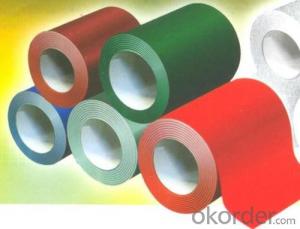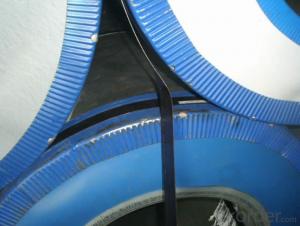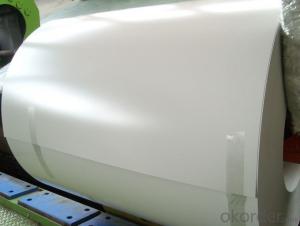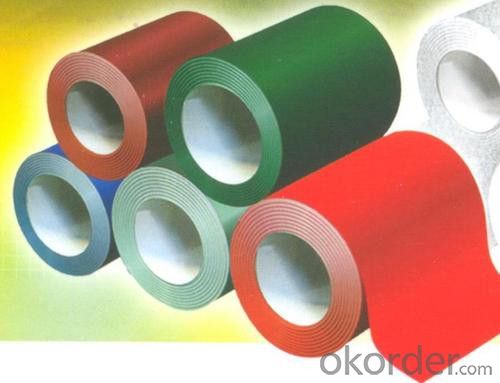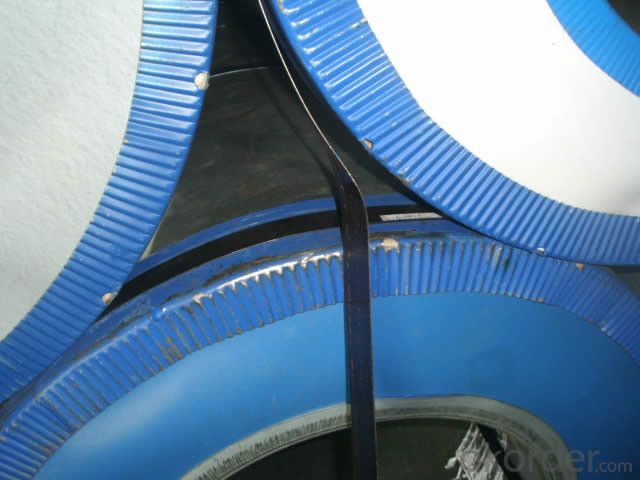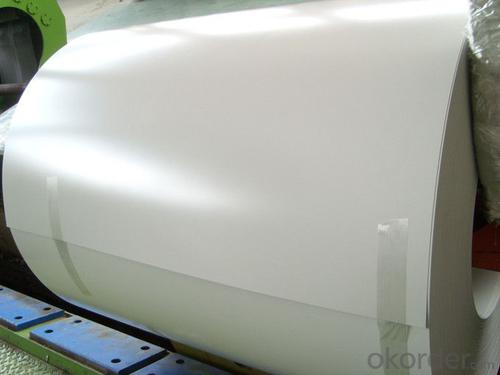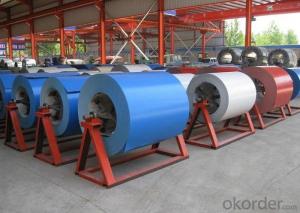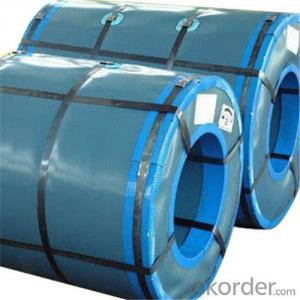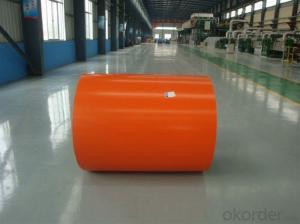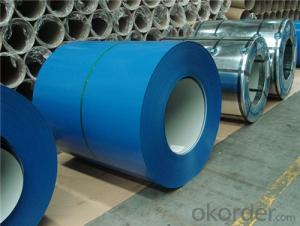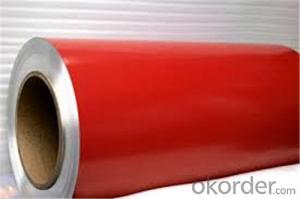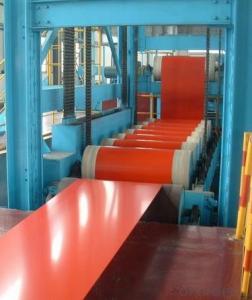Prepainted Rolled Steel coil for construction Roofing Constrution
- Loading Port:
- Shanghai
- Payment Terms:
- TT OR LC
- Min Order Qty:
- 50 m.t.
- Supply Capability:
- 30000 m.t./month
OKorder Service Pledge
OKorder Financial Service
You Might Also Like
Structure of Prepainted Rolled steel Coil for Construction Roofing
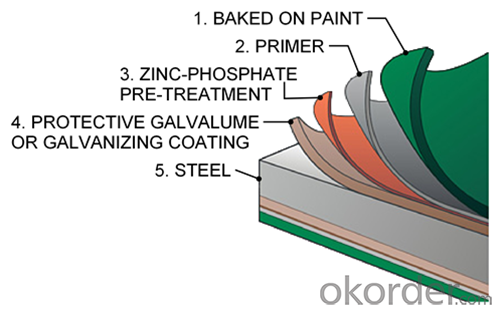
Description of Prepainted Rolled steel Coil for Construction Roofing
Prepainted Rolled steel Coil is a kind of coated steel coil/sheet. With the cold rolled steel of different strength and thickness as substrate, it is produced through applying Al-Zn coat on both faces by hot dip process. In its coating, Al accounts for about 55%, Si 1.6%, while the remaining is Zn. Aluminum zinc coils enjoys both the physical protective feature and durability of Al and the electrochemical protective property of Zn. And its surface has bright silver color and regular embossed-like figure, which are highly decorative.
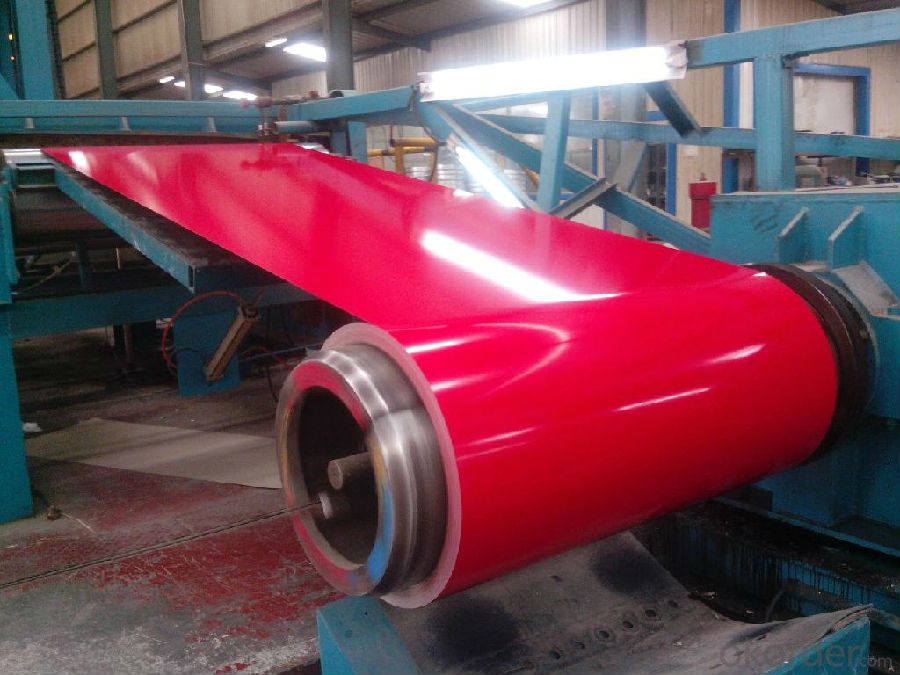
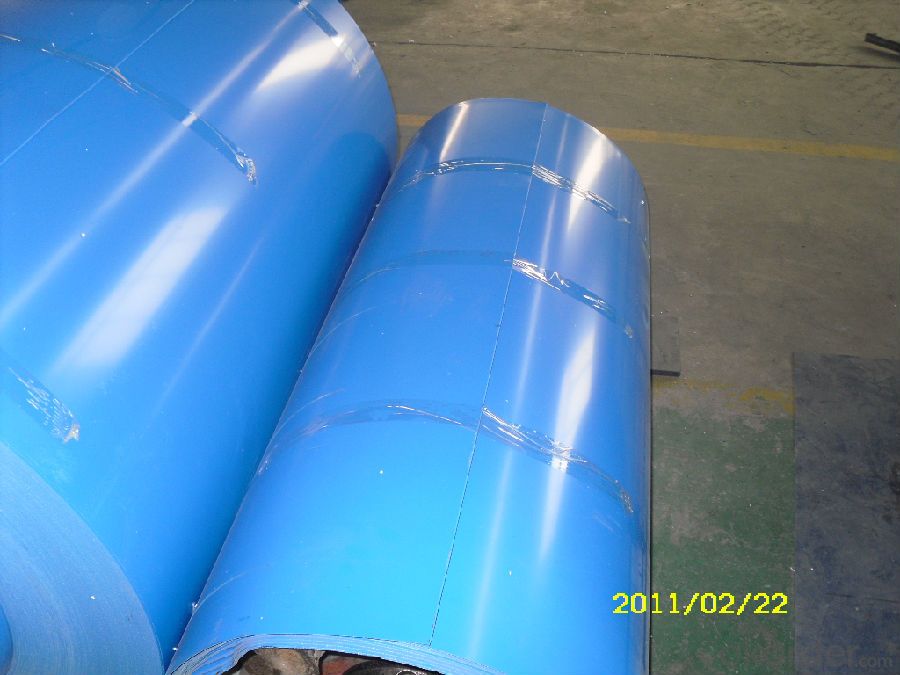
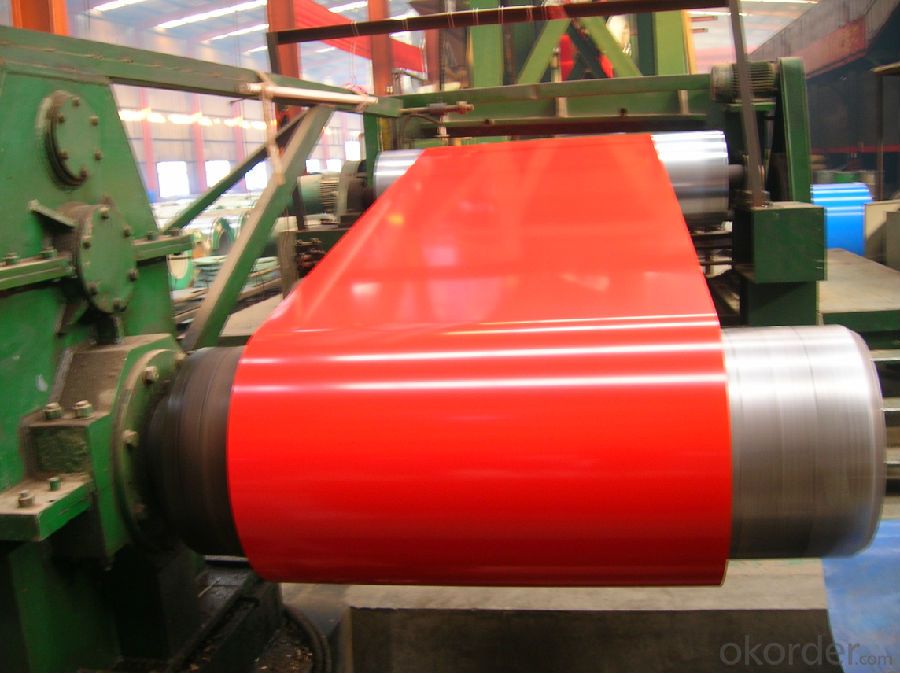
Main Feature of Prepainted Rolled steel Coil for Construction Roofing
1.Corrosion resistance: It mainly depends on the aluminum protection. When the zinc being worn, the aluminum will form a dense layer of aluminum oxide, resist corrosion material to prevent further corrosion inside.
2. Heat resistance: Aluminum zinc alloy steel sheet has excellent heat resistance, can withstand high temperatures over 300 centigrade, and is similar with aluminized steel high temperature oxidation resistance. It often used in chimney pipes, ovens, fluorescent lighting device and the device cover.
3. Heat reflective: Galvanized steel plate heat-reflective high rate is twice as galvanized steel, often used to make insulation materials.
4. Economy: Because density of 55% AL-Zn is smaller than the density of Zn, so in the same weight and thickness of Galvanized zinc layer, aluminum-zinc steel plate is larger area more than 3% of galvanized steel sheet.
Applications of Prepainted Rolled steel Coil for Construction Roofing
1. Construction and building: roofing; ventilating duct; handrail; partition panel;etc.
2. Electric appliance: refrigerator; washing machine; refrigerator; DVD;etc.
3.Transportation: oil tank; road sign; etc.
4.Agriculture:barn; etc.
5.Others:vending machine; game machine; etc.
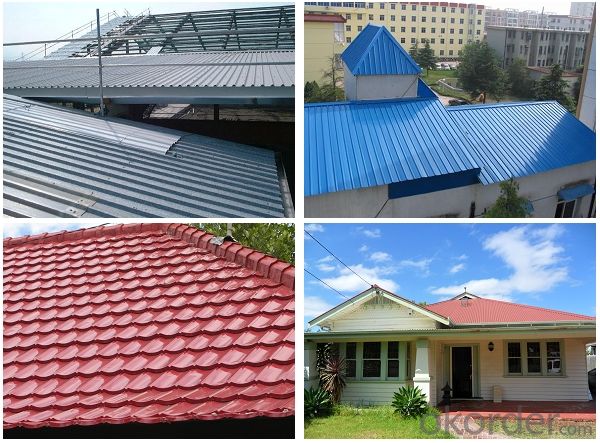
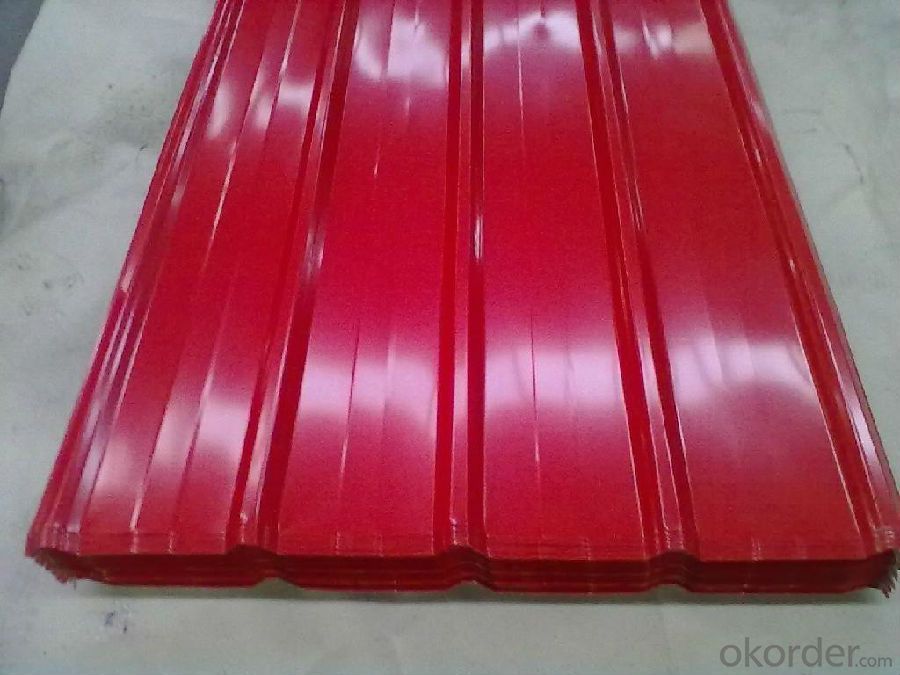
Specifications of Rolled steel Coil for Construction Roofing
Product | Prepainted Rolled steel Coil for Construction Roofing |
Material Grade | SGCC / SGCH / DX51D+AZ, etc |
Thickness | 0.2-3.0mm |
Width | 600-1500mm |
Tolerance | Thickness: +/-0.02mm , Width:+/-2mm |
Zinc-coating | AZ40-150g/m2 |
Technique | Raw material: Hot rolled steel coil --> Cold rolled_>hot dipped galvalume |
Surface | Dried, Chromated, Unoiled |
Spangle | Regular spangle , small spangle, zero spangle |
ID | 508MM |
Coil weight | 10MT max |
Export package | Cardboard inner sleeves, Waterproof paper, galvanized steel covered and steel strip packed |
FAQ of Prepainted Rolled steel Coil for Construction Roofing
We have organized several common questions for our clients,may help you sincerely:
1. What is the minimum order quantity ?
Our MOQ is 50mt for each size. And we will consider to give more discount if you make big order like 1000 tons and more. Further more, the more appropriate payment term your offer the better price we can provide.
2. How long can we receive the product after purchase?
Usually within thirty working days after receiving buyer’s advance payment or LC. We will arrange the factory manufacturing as soon as possible. The cargo readiness usually takes 15-25 days, but the shipment will depend on the vessel situation.
3. How to guarantee the quality of the products?
We have established the international advanced quality management system,every link from raw material to final product we have strict quality test;We resolutely put an end to unqualified products flowing into the market. At the same time, we will provide necessary follow-up service assurance.
- Q: How are steel coils processed for painting or coating?
- Steel coils are processed for painting or coating through a series of steps. Firstly, the coils are cleaned to remove any dirt, oil, or scale using various methods like acid pickling or mechanical cleaning. Then, a primer or chemical treatment is applied to enhance the adhesion of the paint or coating. Next, the coils are dried to remove moisture and ensure proper adhesion. Finally, the paint or coating is applied to the coils using methods such as coil coating or electrostatic spraying, and then the coated coils are cured to achieve the desired finish and durability.
- Q: My neighbor who has an older model mustang installed a steel clutch in it and has blown 4 transmissions as a result.Can any mechanic explain why a steel clutch would kill transmissions? What other modifications would the car need in order to prevent this?
- figger he would learn after a tranny or two...no reasion for any clutch to wreck a tranny.must b bad instalation..or he cant drive
- Q: What are the different types of steel coil leveling methods?
- There are several different steel coil leveling methods, including roller leveling, stretcher leveling, and temper leveling.
- Q: I have hundreds of pounds of scrap steel... who purchases this steel and what is the price per pound etc. of this? Does someone pick it up or do I bring it somewhere?
- Right now, steel is worth $150/ton. Who purchase it? Well, not every scrap yard handle steel, you have to call them up, or look at the company name that has the word steel or iron. But price can vary from each scrap yard. Try to call around. As for someone to pick it up, the scrap yard will mostly charge you a trucking fee and then the price for steel would be lower. But here is another bad thing if you have it pick up. I know some scrap yard are bad...reall bad..they will skim off some weight...a 1k lbs to 2k lbs. Wish you good luck!
- Q: What are the factors to consider when selecting a supplier for steel coils?
- When selecting a supplier for steel coils, there are several factors that need to be taken into account. Firstly, the reputation of the supplier in terms of providing high-quality steel coils is crucial. It is important for the steel coils to meet industry standards and have consistent quality to ensure the durability and performance of the final product. Secondly, the supplier should be reliable and able to consistently meet the demand for steel coils. They should have a proven track record of delivering on time and efficiently handling large orders. The cost of the steel coils is also a significant factor to consider. While competitive prices are important, it is equally important to ensure that the quality is not compromised. It is advisable to compare prices from multiple suppliers to find the best balance between cost and quality. It is also important to look for a supplier that offers a wide range of steel coil products. This will provide various options to choose from and ensure that the exact specifications and dimensions that meet the requirements are available. A supplier with technical expertise and experience in the steel industry can be valuable. They can provide advice and assistance in selecting the right steel coils for specific needs and help with any customization or special requirements. Considering the location and delivery capabilities of the supplier is also important. Choosing a supplier who is geographically closer to the facility can help reduce transportation costs and lead times. Lastly, good customer service is always preferable. The supplier should be responsive to inquiries, provide timely updates, and be willing to address any issues or concerns that may arise. By taking these factors into consideration, an informed decision can be made to choose a supplier that best meets the requirements for steel coils.
- Q: What are the different types of steel coil transport methods?
- There are several different types of steel coil transport methods, including trucking, rail transportation, and sea freight. Trucking involves using flatbed trucks or specialized trailers to transport steel coils over short distances. Rail transportation utilizes flatcars or specialized railcars to transport steel coils over long distances. Sea freight involves shipping steel coils in containers or on specialized vessels across international waters.
- Q: every time i look for steel over the internet like to build cars motorcycles ect i only get steel pipes where can i get steel sheets
- This okorder /... Most towns have a steel supply house/ business, check your yellow pages. Also check with local welding and machine shops. They can give you ideas and or their suppliers. They often have bits and pieces that you might buy, instead of ordering a full sheet of material. Wingman
- Q: How do steel coils contribute to the automotive lightweighting trend?
- Steel coils contribute to the automotive lightweighting trend in several ways. First and foremost, steel coils are used in the production of advanced high-strength steels (AHSS) which offer a higher strength-to-weight ratio compared to traditional steel grades. These AHSS can provide the same structural integrity as conventional steel, but with reduced weight. By incorporating AHSS into the construction of vehicle components such as body panels, chassis, and suspension systems, automakers can reduce the overall weight of the vehicle, thus improving fuel efficiency and reducing emissions. Furthermore, steel coils are used in the manufacturing of tailor-rolled blanks (TRBs). TRBs are formed by welding or bonding different steel grades together in a coil before stamping them into the desired shape. This allows for the optimization of material usage, as stronger steel grades can be strategically placed in areas that require higher strength, while lighter grades can be used in less critical areas. This technique not only reduces weight but also enhances safety by reinforcing necessary areas of the vehicle. Moreover, steel coils enable the production of thinner and more formable steel sheets. The advancements in steelmaking technology have allowed for the development of thinner gauges without compromising strength and durability. Thinner steel sheets are easier to shape and form, enabling the creation of complex and lightweight automotive parts. This not only reduces weight but also improves design flexibility and aerodynamics, leading to enhanced performance and fuel efficiency. In addition, steel coils contribute to cost-effectiveness in lightweighting efforts. Steel is a relatively affordable material compared to alternatives like aluminum or carbon fiber. By utilizing steel coils, automakers can achieve lightweighting goals while keeping manufacturing costs under control. This affordability aspect is particularly important in the automotive industry, where cost considerations play a significant role in the design and production of vehicles. In summary, steel coils play a crucial role in the automotive lightweighting trend by enabling the production of advanced high-strength steels, tailor-rolled blanks, thinner and more formable steel sheets, and cost-effective lightweight solutions. These advancements contribute to improved fuel efficiency, reduced emissions, enhanced safety, and increased design flexibility, all of which are key factors in the ever-evolving automotive industry.
- Q: What are the common coil surface treatments available for steel coils?
- There are several common coil surface treatments available for steel coils, each serving different purposes and offering various benefits. These treatments aim to enhance the durability, corrosion resistance, and appearance of the steel coils. 1. Galvanized Coating: Galvanization is a popular treatment in which a layer of zinc is applied to the steel coil's surface. This coating provides excellent corrosion protection, preventing rust and extending the lifespan of the coil. It is commonly used in outdoor applications or environments with high humidity levels. 2. Phosphating: Phosphating is a chemical treatment that forms a thin layer of phosphate coating on the steel coil's surface. This treatment enhances the adhesion of subsequent coatings and improves the coil's paintability. It also offers some corrosion resistance and can be used as a pre-treatment before painting or powder coating. 3. Chromate Conversion Coating: Chromate conversion coating, also known as chem film or Alodine, involves applying a thin layer of chromate to the steel coil's surface. This treatment offers corrosion protection and acts as a primer for subsequent coatings, improving their adhesion. It is often used in aerospace and electrical applications. 4. Powder Coating: Powder coating is a dry finishing process in which a fine powder is applied to the steel coil's surface electrostatically and then cured under heat. This treatment provides a durable and attractive finish, offering excellent resistance to chipping, scratching, and fading. Powder coating is available in a wide range of colors and textures, making it a versatile option. 5. Organic Coatings: Organic coatings, such as acrylic, polyester, or polyurethane, are applied to the steel coil's surface as liquid paints. These coatings provide aesthetic appeal, protection against corrosion, and resistance to weathering and UV radiation. Organic coatings are often used in architectural and automotive applications. 6. Anodizing: Anodizing is a treatment primarily used for aluminum coils but can also be applied to steel coils. It involves creating an oxide layer on the surface of the coil through an electrochemical process. This treatment enhances the coil's corrosion resistance and provides an attractive finish. Anodizing is commonly used in architectural and decorative applications. It's important to note that the choice of coil surface treatment depends on the specific requirements of the application, including the desired performance, aesthetics, and environmental factors. Consulting with a professional in the steel industry can help determine the most suitable treatment for a particular project.
- Q: What are the common coil slitting equipment used in the industry?
- The common coil slitting equipment used in the industry includes slitter rewinders, slitter cutters, and slitter knives. These machines are designed to accurately cut and rewind coils of various materials, such as metal, paper, and plastic, into narrower strips or coils of desired widths.
Send your message to us
Prepainted Rolled Steel coil for construction Roofing Constrution
- Loading Port:
- Shanghai
- Payment Terms:
- TT OR LC
- Min Order Qty:
- 50 m.t.
- Supply Capability:
- 30000 m.t./month
OKorder Service Pledge
OKorder Financial Service
Similar products
Hot products
Hot Searches
Related keywords
